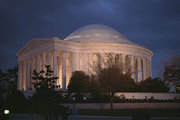Jefferson Memorial
|
|
Jefferson_Memorial_with_Declaration_preamble.jpg
The Jefferson Memorial is a monument in Washington, DC to Thomas Jefferson. It combines a low neo-classical saucer dome with a portico.
By 1930, there were monuments in Washington commemorating great United States presidents such as Abraham Lincoln and George Washington. President Franklin Roosevelt thought that Thomas Jefferson also deserved a monument.
In 1934, following his initiative, Congress passed a resolution to create a monument commemorating Jefferson. The memorial was designed by John Russell Pope (1874 - 1937), the architect of the original (west) building of the National Gallery of Art. It reflects characteristics of buildings designed by Jefferson such as Monticello and the Rotunda, which were a result of his fascination with Roman architecture. It bears a close resemblance to the Pantheon of Rome. The cornerstone was laid in 1939 and the monument cost slightly more than $3 million.
It was officially dedicated on April 13, 1943, after Pope's death and on the 200th anniversary of Jefferson's birth. One of the last American public monuments in the Beaux-Arts tradition, it was severely criticised even as it was being built, by those who adhered to the modernist argument that dressing 20th-century buildings like Greek and Roman temples constituted a "tired architectural lie." More than 60 years ago, Pope responded with silence to critics who dismissed him as part of an enervated architectural elite practicing "styles that are safely dead".
The interior of the memorial has a 19 foot (5.8 m) tall, 10,000 pound (4.5 t) bronze statue of Jefferson by sculptor Rudolph Evans which was added four years after the dedication, and the interior walls are engraved with passages from Jefferson's writings. Most prominent are the words which are inscribed around the monument near the roof: "I have sworn upon the altar of God eternal hostility against every form of tyranny over the mind of man." This sentence is taken from a September 23, 1800 letter (http://odur.let.rug.nl/~usa/P/tj3/writings/brf/jefl134.htm) by Jefferson to Dr. Benjamin Rush.
The 129 foot (39 m) dome is 4 feet (1.2 m) thick and the memorial weighs 32,000 short tons (29 gigagrams).
The site of the monument in West Potomac Park, on the shore of the Potomac River Tidal Basin, is enhanced with the massed planting of Japanese cherry trees, the gift of the people of Japan in 1912.
The monument is not as prominent in popular culture as other Washington, DC buildings and monuments, possibly due to its location well removed from the National Mall and the Washington Metro. A character visits the memorial at the end of the film Bob Roberts. In an episode of The Simpsons, Lisa Simpson visits the memorial and Jefferson laments "No one ever comes to see me. I don't blame them. I never did anything important. Just the Declaration of Independence, the Louisiana Purchase, the dumbwaiter...Wait! Please don't go. I get so lonely..."
External links
- National Park Service: Thomas Jefferson Memorial (http://www.nps.gov/thje/)
- Controversies round construction of this memorial. (http://www.nps.gov/thje/memorial/planning.htm)
- The history of the Thomas Jefferson Memorial (http://sdsd.essortment.com/thomasjefferson_rjdb.htm)
- Thomas Jefferson and the Jefferson Memorial from Washington, DC Metroweb (http://washingtondcmetroweb.com/jeffersonmemorial.htm)
Template:Geolinks-US-buildingscale
Reference
- Bedford, Steven McLeod, John Russell Pope: Architect of Empire, Rizzoli International Publications, Inc., New York, NY 1998
- Goode, James M. The Outdoor Sculpture of Washington D.C., Smithsonian Institute Press, Washington D.C. 1974


